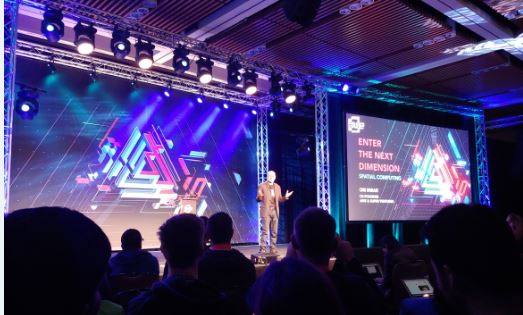June 1st, 2019, By Jennifer Colegrove Ph.D. Principal Analyst, Touch Display Research Inc.
I just returned from AWE (Augmented World Expo) USA 2019 conference. This is my fourth year to attend the AWE conference. According to the keynote speaker—Mr. Ori Inbar, co-founder and CEO of AugmentedReality.org, this year the attendee number has reached over 7000, which is a record high in the 10 years history of AWE conference.
Figure 1: AWE USA 2019 Keynote

Photo source: Touch Display Research
The key takeaways are:
- Augmented reality and virtual reality is expanding in both enterprise and consumer market. Hundreds of enterprises are already using AR/VR and AI to help with saving cost. Consumer market is also gearing up with a dozen applications showing at this year’s AWE exhibition.
- Investment to the AR/VR and AI are accelerating.
- Human machine interface (HMI) still need improvement. We are still not there yet. The combination of several sensor fusions are needed. There are over 20 types of sensor technologies are used for augmented reality (AR), virtual reality (VR), and artificial intelligence (AI) applications.
Figure 2: Sensor technologies for AR VR and AI
| 10 sensor technologies categories for AR VR AI | |
| 1 | Camera-based gesture |
| 2 | Camera-based eye tracking |
| 3 | Ultrasound or radar-based gesture |
| 4 | Voice recognition |
| 5 | Photodiode sensor |
| 6 | Proximity touch screen |
| 7 | Motion sensor fusion |
| 8 | Short-range wireless sensor |
| 9 | Other touchless tech |
| 10 | Touch sensors and touch pad |
Source: Sensors for Augmented Reality, Virtual Reality and Artificial Intelligence market 2016 Report. Touch Display Research Inc.
Touch Display Research forecasts that sensors for AR, VR, and AI market will reach $160 billion in 2022.
More analysis and review can be found in the “Touch and Emerging Display monthly report” report.
Thanks for reading,
Dr. Jennifer Colegrove and team
